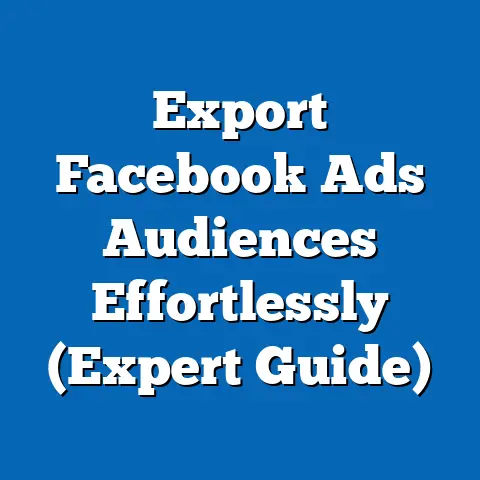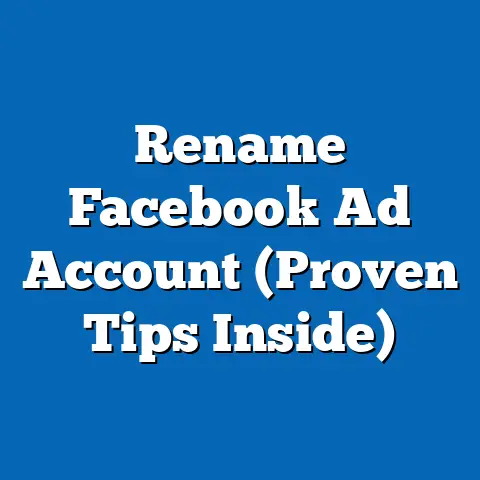Maximize Reach with Group-Focused Facebook Ads (Expert Guide)
Have you ever considered that a single Facebook ad campaign could resonate differently with a Baby Boomer than with a Gen Z user, even if the product is the same? In the ever-evolving landscape of digital marketing, understanding generational nuances is not just a bonus—it’s a necessity for maximizing reach and engagement. This article dives deep into the strategy of group-focused Facebook ads, with a particular emphasis on tailoring campaigns to specific generational cohorts, exploring their defining characteristics, historical contexts, and the broader societal implications of such targeted marketing.
Generational targeting is more than just segmenting an audience by age; it’s about crafting messages that align with the unique values, experiences, and technological behaviors shaped by the era in which each group came of age. By leveraging these insights, marketers can create hyper-relevant content that drives higher click-through rates, conversions, and brand loyalty. Let’s explore how to harness this powerful approach on one of the world’s largest advertising platforms—Facebook.
Section 1: Understanding Generational Cohorts and Their Defining Characteristics
Generational cohorts are groups of individuals born within a specific time frame, often spanning 15-20 years, who share similar cultural, social, and economic experiences during their formative years. These shared experiences shape their attitudes, behaviors, and preferences, making generational analysis a critical tool for marketers. However, it’s important to note that while generational labels provide a useful framework, they are not monolithic—diversity within each group exists due to factors like geography, socioeconomic status, and individual personality.
Baby Boomers (Born 1946-1964)
Baby Boomers, often associated with post-World War II optimism, are defined by their strong work ethic and traditional values. Many grew up during a time of economic prosperity and social change, including the Civil Rights Movement and the rise of television as a cultural force. As digital immigrants, they have adapted to technology later in life, often using Facebook to stay connected with family and engage with nostalgic content.
Generation X (Born 1965-1980)
Generation X, sometimes called the “latchkey generation,” is known for its independence and skepticism, shaped by economic uncertainty and the advent of personal computing. They witnessed the transition from analog to digital, making them adaptable to technology while valuing privacy. On Facebook, Gen Xers often seek practical information and are less swayed by flashy trends compared to younger cohorts.
Millennials (Born 1981-1996)
Millennials, or Generation Y, are digital natives who came of age during the internet boom and the 2008 financial crisis. They prioritize experiences over material possessions, value authenticity, and are heavily influenced by social media trends. On platforms like Facebook, Millennials engage with brands that align with their social values and offer personalized content.
Generation Z (Born 1997-2012)
Generation Z, the first fully digital-native cohort, grew up with smartphones and social media as integral parts of their lives. They are pragmatic, socially conscious, and value diversity, often using platforms like Facebook for community engagement and activism. Their short attention spans demand visually striking, concise ads that resonate with their desire for individuality.
Recognizing these characteristics is the first step in crafting effective group-focused ads. However, understanding the historical events and societal shifts that shaped these traits is equally important for creating campaigns that truly connect.
Section 2: Historical Context Shaping Generational Identities
Each generation’s worldview is a product of the historical events and cultural shifts they experienced during their formative years. These contexts influence not only personal values but also how individuals interact with technology and advertising. Let’s examine the key historical influences for each cohort and their implications for Facebook ad strategies.
Baby Boomers: Post-War Prosperity and Social Upheaval
Born in the aftermath of World War II, Baby Boomers grew up during a time of economic growth and cultural transformation in the United States and beyond. The 1960s and 1970s brought significant events like the moon landing, the Vietnam War, and the rise of counterculture movements, instilling a mix of optimism and activism in this generation. For marketers, ads targeting Boomers on Facebook should evoke nostalgia, emphasize trust, and focus on family-oriented messaging, as these themes resonate with their life experiences.
Generation X: Economic Instability and Technological Transition
Gen Xers came of age during periods of economic recession in the 1980s and early 1990s, coupled with the rise of dual-income households, which often left them with greater independence. They also witnessed the birth of the internet and the shift from traditional media to digital platforms. Ads for Gen X should highlight practicality, reliability, and value, as this generation tends to be discerning and research-focused when making purchasing decisions on platforms like Facebook.
Millennials: Digital Revolution and Economic Challenges
Millennials entered adulthood during the rapid expansion of the internet and social media, alongside the global financial crisis of 2008, which shaped their skepticism toward traditional institutions. They value peer recommendations and user-generated content, often turning to social platforms for product reviews. Facebook ads targeting Millennials should prioritize authenticity, social impact, and interactive elements like polls or user stories to build trust and engagement.
Generation Z: Post-9/11 Realities and Digital Ubiquity
Gen Z grew up in a post-9/11 world marked by global uncertainty, climate change concerns, and the omnipresence of technology. They are accustomed to instant access to information and are highly attuned to social justice issues. For marketers, creating visually dynamic, short-form content that speaks to inclusivity and sustainability is key to capturing Gen Z’s attention on Facebook, where they often engage with causes and communities.
Understanding these historical contexts allows marketers to craft messages that resonate on a deeper level. However, the effectiveness of group-focused ads also depends on navigating the technological and behavioral differences across generations.
Section 3: Technological and Behavioral Trends in Generational Facebook Use
Facebook, with over 2.9 billion monthly active users as of 2023 (Statista), remains a dominant platform for reaching diverse generational audiences. However, how each cohort interacts with the platform varies significantly due to their technological fluency and social habits. Tailoring ad strategies to these behaviors is crucial for maximizing reach.
Baby Boomers: Connectivity and Caution
Baby Boomers are among the fastest-growing demographic on Facebook, often using it to connect with family and friends or join interest-based groups. However, they may be less comfortable with complex digital interfaces and more cautious about privacy. Ads targeting Boomers should use clear, straightforward calls-to-action and avoid overly technical language while reassuring them about data security.
Generation X: Balanced Engagement
Gen Xers use Facebook for a mix of personal and professional purposes, often engaging with content related to hobbies, news, and local events. They are less likely to overshare compared to younger generations and value privacy. Ads for this group should focus on informative content, such as how-to guides or product comparisons, and avoid aggressive sales tactics.
Millennials: Social and Trend-Driven
Millennials are highly active on Facebook, often using it alongside other platforms like Instagram for social interaction and brand discovery. They respond well to influencer partnerships and user-generated content. Campaigns targeting Millennials should incorporate storytelling, visually appealing designs, and opportunities for engagement, such as contests or interactive posts.
Generation Z: Visual and Community-Focused
While Gen Z may favor platforms like TikTok and Instagram, many still use Facebook for group interactions, event planning, and marketplace activities. Their preference for video content and short, snappy messaging means ads must be visually captivating and concise. Incorporating memes, GIFs, and user-driven campaigns can significantly boost engagement with this cohort.
By aligning ad formats and messaging with these behavioral trends, marketers can create more effective campaigns. Yet, the economic and cultural factors influencing purchasing power and brand perception also play a critical role in shaping ad strategies.
Section 4: Economic and Cultural Influences on Generational Responses to Ads
Economic conditions and cultural values directly impact how generations perceive and respond to advertising. These factors influence everything from purchasing decisions to brand loyalty, making them essential considerations for group-focused Facebook ads.
Baby Boomers: Financial Stability and Traditional Values
Many Baby Boomers are in or nearing retirement, often with significant disposable income but a focus on value-driven purchases. Culturally, they tend to prioritize quality and reliability over trends. Ads should highlight long-term benefits, customer testimonials, and loyalty programs to appeal to their preference for trusted, established brands.
Generation X: Pragmatism Amid Economic Pressures
Gen Xers often juggle family responsibilities and career demands, making them value-conscious consumers. They are less likely to be swayed by hype and more focused on practical solutions. Facebook ads targeting Gen X should emphasize cost-effectiveness, durability, and problem-solving features to align with their pragmatic mindset.
Millennials: Experience-Driven Spending
Millennials, often burdened by student debt and economic uncertainty, prioritize experiences and social impact over material goods. They are drawn to brands that demonstrate corporate responsibility and transparency. Ads for Millennials should showcase a brand’s mission, sustainability efforts, and opportunities for shared experiences, such as events or community initiatives.
Generation Z: Socially Conscious Consumers
Gen Z has grown up in an era of economic instability and global challenges, making them frugal yet socially conscious spenders. They are quick to reject brands that seem inauthentic or out of touch with issues like diversity and climate change. Facebook ads targeting Gen Z must reflect genuine values, leverage influencer partnerships, and offer affordable, innovative solutions.
These economic and cultural dynamics highlight the need for nuanced ad strategies. However, group-focused advertising also raises important societal and ethical questions that marketers must address.
Section 5: Societal Implications and Ethical Considerations of Generational Targeting
While group-focused Facebook ads can significantly enhance reach and engagement, they also come with societal implications that warrant careful consideration. Targeted advertising has the potential to reinforce generational stereotypes, exacerbate divides, and raise privacy concerns, all of which can impact public perception of brands.
Reinforcing Stereotypes and Generational Divides
By tailoring ads to specific generational traits, marketers risk oversimplifying complex identities and perpetuating clichés—such as portraying all Baby Boomers as tech-averse or all Gen Zers as trend-obsessed. This can alienate individuals who don’t fit the mold and deepen misunderstandings between generations. To mitigate this, campaigns should emphasize shared values and avoid reductive messaging, ensuring inclusivity within targeted groups.
Privacy and Data Ethics
Generational targeting relies heavily on data collection, from demographic information to behavioral insights gathered through Facebook’s algorithms. While this enables precise ad delivery, it also raises concerns about privacy, especially among older generations like Baby Boomers and Gen X, who may be more wary of data misuse. Marketers must adhere to data protection regulations like GDPR and CCPA, transparently communicate data usage, and offer opt-out options to build trust.
Cultural Sensitivity and Social Impact
Ads that resonate with one generation may inadvertently offend another due to differing cultural norms or historical sensitivities. For instance, humor or references that appeal to Gen Z might be misunderstood by Baby Boomers. Marketers must test campaigns across diverse audiences and remain attuned to cultural shifts to avoid backlash and foster positive societal impact.
Addressing these implications requires a balance between effective targeting and ethical responsibility. By prioritizing transparency and inclusivity, brands can maximize reach without compromising trust or social harmony.
Section 6: Practical Strategies for Group-Focused Facebook Ads
Now that we’ve explored generational characteristics, historical contexts, and societal implications, let’s turn to actionable strategies for creating effective group-focused Facebook ads. These tips are grounded in data-driven insights and best practices for maximizing reach across cohorts.
1. Segment Audiences with Precision Using Facebook Ads Manager
Facebook’s Ads Manager offers robust tools for segmenting audiences by age, interests, and behaviors. Use these features to create distinct campaigns for each generational group, ensuring that messaging aligns with their preferences. For example, target Baby Boomers with ads for retirement planning services, while focusing on eco-friendly products for Gen Z.
2. Customize Ad Formats to Generational Behaviors
Different generations respond to different ad formats. Baby Boomers and Gen Xers may engage more with carousel ads showcasing detailed product information, while Millennials and Gen Z prefer video ads or Stories that offer quick, visually engaging content. Test multiple formats to identify what resonates best with each group.
3. Craft Messages That Reflect Generational Values
Tailor ad copy to reflect the core values of each cohort. For Baby Boomers, emphasize trust and nostalgia with phrases like “Trusted for Generations.” For Millennials, highlight social impact with messages like “Join Us in Making a Difference.” For Gen Z, focus on individuality with calls-to-action like “Be You, Be Bold.”
4. Leverage Lookalike Audiences for Broader Reach
Once you’ve identified high-performing generational segments, use Facebook’s Lookalike Audience feature to find similar users who share comparable traits. This can help expand your reach while maintaining relevance, ensuring that your ads connect with a wider yet still targeted audience.
5. Monitor and Optimize Campaigns Continuously
Generational preferences evolve over time, influenced by cultural shifts and technological advancements. Use Facebook Insights to track ad performance metrics like click-through rates and engagement levels across different age groups. Adjust campaigns based on data to ensure ongoing relevance and effectiveness.
Implementing these strategies can significantly enhance the impact of your Facebook ad campaigns. However, success also depends on staying attuned to emerging trends and adapting to future generational dynamics.
Section 7: Forward-Looking Insights and Uncertainties
As digital marketing continues to evolve, so too will the strategies for generational targeting on platforms like Facebook. Emerging technologies like artificial intelligence and augmented reality are likely to further personalize ad experiences, while shifts in generational demographics—such as the rise of Generation Alpha (born 2013 onwards)—will introduce new challenges and opportunities.
One uncertainty lies in the potential saturation of targeted advertising. As users become more aware of data-driven marketing tactics, they may develop “ad fatigue” or push back against perceived intrusions, particularly among privacy-conscious generations like Gen X and Gen Z. Marketers will need to innovate by focusing on value-driven content and authentic engagement to maintain trust.
Additionally, the growing influence of cross-generational trends, such as sustainability and mental health awareness, may blur traditional cohort boundaries. Brands that can unite generations around shared causes—through campaigns that transcend age-based targeting—may find greater success in fostering long-term loyalty.
Finally, the ethical landscape of digital advertising will continue to evolve, with increasing scrutiny on data privacy and algorithmic bias. Marketers must stay ahead of regulatory changes and prioritize transparency to navigate these uncertainties effectively.
Conclusion: Harnessing Generational Insights for Maximum Impact
Maximizing reach with group-focused Facebook ads requires a deep understanding of generational characteristics, historical contexts, and societal dynamics. By tailoring campaigns to the unique values, behaviors, and technological preferences of Baby Boomers, Gen X, Millennials, and Gen Z, marketers can create meaningful connections that drive engagement and conversions. However, this approach must be balanced with ethical considerations to avoid reinforcing stereotypes or compromising trust.
As we look to the future, the interplay between technological innovation, cultural shifts, and generational evolution will continue to shape the landscape of digital advertising. While uncertainties remain, one thing is clear: brands that invest in nuanced, data-driven strategies while prioritizing inclusivity and authenticity will be best positioned to succeed in reaching diverse audiences on platforms like Facebook.
By embracing the complexities of generational targeting, marketers can transform challenges into opportunities, building campaigns that not only maximize reach but also contribute positively to societal understanding across age groups. The question remains—are you ready to adapt and connect with every generation on their terms?





